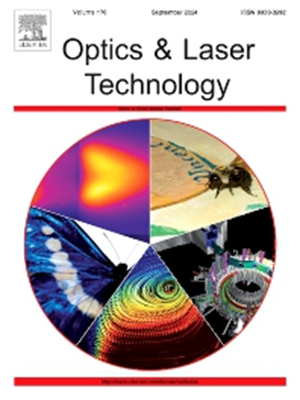Roughness prediction in hatched laser scanning polishing based on critical spatial frequency
IF 4.6
2区 物理与天体物理
Q1 OPTICS
引用次数: 0
Abstract
In the study of laser polishing, the modeling of hatched laser scanning polishing, which must take into account the initial surface micro-morphology and scanning path simultaneously, is still a challenge. To address the problem, this paper presents an improved surface roughness prediction model based on spatial frequency analysis. The initial surface morphology was simplified into a micro-textured surface. And then A 3D FEA heat conduction model of the micro-texture in hatched laser scanning polishing was established to evaluate the melting depth and melting duration in the hatched scanning traces. Subsequently, based on the evaluated melting durations, the critical spatial frequency was calculated and the spatial spectrum of polished surface profile was evaluated. And thus, the profile and the average roughness Ra of the polished surface were determined by inverse Fourier transform. By comparing the predicted result with the measured surface roughness in hatched laser scanning polishing test, it indicates that the proposed model allows for accurate predictions of polished finish with predicted error range from −9.5 % to 8.9 %, which is much smaller than that of other traditional spatial frequency analysis model of laser polishing.
求助全文
约1分钟内获得全文
求助全文
来源期刊
CiteScore
8.50
自引率
10.00%
发文量
1060
审稿时长
3.4 months
期刊介绍:
Optics & Laser Technology aims to provide a vehicle for the publication of a broad range of high quality research and review papers in those fields of scientific and engineering research appertaining to the development and application of the technology of optics and lasers. Papers describing original work in these areas are submitted to rigorous refereeing prior to acceptance for publication.
The scope of Optics & Laser Technology encompasses, but is not restricted to, the following areas:
•development in all types of lasers
•developments in optoelectronic devices and photonics
•developments in new photonics and optical concepts
•developments in conventional optics, optical instruments and components
•techniques of optical metrology, including interferometry and optical fibre sensors
•LIDAR and other non-contact optical measurement techniques, including optical methods in heat and fluid flow
•applications of lasers to materials processing, optical NDT display (including holography) and optical communication
•research and development in the field of laser safety including studies of hazards resulting from the applications of lasers (laser safety, hazards of laser fume)
•developments in optical computing and optical information processing
•developments in new optical materials
•developments in new optical characterization methods and techniques
•developments in quantum optics
•developments in light assisted micro and nanofabrication methods and techniques
•developments in nanophotonics and biophotonics
•developments in imaging processing and systems

 求助内容:
求助内容: 应助结果提醒方式:
应助结果提醒方式:


